Rhythm and Rhyme: Unlocking the Power of Music as a Tool for Learning Disability Support
Introduction
In the vast landscape of educational support, one innovative approach is capturing the attention of educators, therapists, and parents alike: music. As we embark on this journey of understanding, we find that Rhythm and Rhyme: Exploring Music as a Tool for Learning Disability Support is not just an academic phrase—it’s a transformative pathway to enhancing the learning experience for individuals with diverse needs. The intersection of music and education holds immense potential, offering unique strategies to unlock the abilities and talents of those with learning disabilities.
Imagine a classroom where students are engaged, motivated, and thriving through the medium of music. Picture a world where rhythm and melody serve as bridges to understanding complex concepts and emotions, turning challenges into opportunities. As we delve deeper into this subject, we will uncover research, case studies, and real-world examples that highlight the significant role of music in supporting learning disabilities.
The Power of Music in Learning
Understanding Learning Disabilities
Learning disabilities encompass a range of disorders that affect the acquisition and use of listening, speaking, reading, writing, reasoning, or mathematical abilities. Examples include dyslexia, ADHD, and autism spectrum disorder (ASD). These challenges can hinder traditional learning methods, often leading to frustration for both students and educators.
Music as a Form of Expression
Music is inherently rhythmic and melodic, enabling individuals to express feelings and concepts that words alone may fail to convey. The brain’s response to music is profound; studies show that engaging with music activates multiple areas of the brain, fostering emotional connections and cognitive processing. For learners with disabilities, the structured yet flexible nature of music can be particularly supportive.
Rhythm and Rhyme: A Framework for Learning
The Science Behind Music and Learning
Effects of Rhythm on Memory and Learning
Research has shown that rhythmic patterns can significantly enhance memory retention. The integration of rhythm encourages repetitive learning through catchy melodies and beats, enabling learners to recall information more effortlessly. This phenomenon is particularly useful for learners with disabilities, as rhythm helps chunk information into manageable pieces.
Rhyme and Language Development
Rhyme plays a critical role in literacy and language development. It aids phonemic awareness, making it easier for learners to decode words and develop vocabulary skills. By incorporating rhyming songs into educational activities, educators can create an engaging environment that promotes language skills in children with learning disabilities.
Case Study: A Music Program in a Special Education Classroom
A compelling example comes from the Willowbrook School for Special Needs, where a targeted music program was introduced. Utilizing Rhythm and Rhyme: Exploring Music as a Tool for Learning Disability Support, teachers integrated musical activities into the curriculum. The program included singing, playing instruments, and creating rhymes, which led to significant improvements in students’ engagement and learning outcomes.
Analysis
The success of the Willowbrook School’s program illustrates that incorporating music can create an inclusive learning atmosphere. Students who previously struggled with attention and retention began to show enthusiasm and progress, highlighting the effectiveness of music as an instructional tool.
Practical Applications of Music in Education
Classroom Strategies for Integrating Music
- Song-Based Learning: Create educational songs that incorporate key vocabulary or concepts.
- Movement and Dance: Combine music with kinesthetic activities to engage multiple learning styles.
- Instrumental Exploration: Allow students to explore rhythm through drumming, xylophones, or body percussion.
The Role of Rhythmic Games
Rhythmic games can further supplement learning by promoting social skills and teamwork. Games such as "Rhythm Clapping" or "Musical Chairs with a Twist" encourage interaction, listening skills, and cognitive engagement.
Case Study: The Rhythmic Learning Initiative
The Rhythmic Learning Initiative was implemented in several urban schools to address the needs of students with learning disabilities. In this program, teachers employed rhythm-based lessons paired with academic content. The results demonstrated marked improvement in students’ academic performance, self-esteem, and social interaction skills.
Analysis
This initiative shows that when educators embrace music as an integral part of their teaching methods, they can create a dynamic learning environment that accommodates various learners’ needs. By promoting engagement through rhythm and rhyme, students flourish academically and socially.
Enhancing Emotional and Social Development
Music as a Medium for Emotional Expression
Music provides a safe space for learners with disabilities to express their emotions. Whether through songwriting, performing, or simply listening, individuals can explore feelings that may be complex to articulate. This aids in emotional development and provides a sense of belonging.
Encouraging Social Skills Through Group Music Activities
Group music activities foster cooperation, communication, and rhythmical synchronization among peers. Singing in unison or playing in harmony can improve social interaction and teamwork, essential skills for students with learning disabilities.
Case Study: Community Choir for Children with ASD
A community choir designed for children with autism spectrum disorder utilizes the principles of Rhythm and Rhyme: Exploring Music as a Tool for Learning Disability Support. Through weekly rehearsals and performances, children not only develop their musical talents but also enhance their social skills in a supportive environment.
Analysis
The community choir’s positive impact illustrates how music can create connections and build self-esteem. Children who once felt isolated found joy and acceptance through shared musical experiences.
The Importance of Parental Involvement
Encouraging Music at Home
Parents play a crucial role in fostering a musical environment at home. Simple actions like singing together, dancing to favorite songs, or incorporating musical games can reinforce the benefits gained in educational settings.
Workshops for Parents
Schools can provide workshops that educate parents on how to use music as a tool for learning at home. These sessions can equip them with creative strategies to reinforce classroom learning, making education a more holistic experience.
Case Study: Parent-Child Music Workshops
A series of parent-child workshops was established in the Riverside School District to encourage musical engagement at home. Feedback indicated that families reported improved communication and bonding, as music fostered deeper connections and valuable learning experiences.
Analysis
These workshops demonstrate the critical role of parental involvement in reinforcing the benefits of music and learning. When families embrace music together, they create enriching experiences that extend beyond the classroom.
Conclusion
As we’ve explored in this article, Rhythm and Rhyme: Exploring Music as a Tool for Learning Disability Support is more than just a concept—it’s a pivotal approach that harnesses the power of music to enrich the educational experiences of learners with disabilities. From enhancing memory retention through rhythm to encouraging emotional expression and social skills, music serves as a channel for creating vibrant, inclusive learning environments.
The journey toward supporting those with learning disabilities can be transformed into an empowering adventure through the use of music. Parents, educators, and communities are called upon to embrace music’s potential, fostering engagement and joy in learning. The rhythm of innovation and the rhyme of creativity await—let us embrace them wholeheartedly.
FAQs
1. How does music improve memory in students with learning disabilities?
Music, especially rhythmic patterns, helps chunk information, making it easier to recall. Engaging with music activates various brain regions, enhancing memory retention.
2. Can any type of music be beneficial for learning disabilities?
While all music can have positive effects, songs with clear rhythms and lyrics are particularly effective. Genres that are engaging and appropriate for the age group should be chosen to maximize benefits.
3. How can parents incorporate music into their children’s learning at home?
Parents can sing songs, use musical games, and create a musically rich environment by introducing simple instruments. Engaging in music together reinforces what’s learned in school.
4. Are there specific programs targeting music for learning disabilities?
Yes, many schools and organizations run programs focused on music as a therapeutic tool for learning disabilities. Research programs that specialize in music therapy and educational music curriculums.
5. What resources are available for educators wanting to implement music in their classrooms?
There are numerous resources available, including music education websites, workshops, and training programs. Connecting with local music therapists or educators experienced in music integration can also be beneficial.
Through this extensive exploration of rhythm and rhyme in learning disability support, we have unveiled the remarkable capabilities of music in education. As educators and parents, embracing this approach can lead to not just academic success but also joy, connection, and emotional growth for learners of all kinds. Let’s make the world of education more melodic, one note at a time!
















